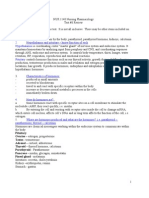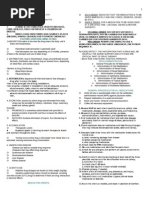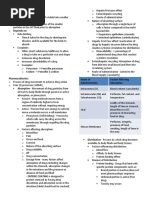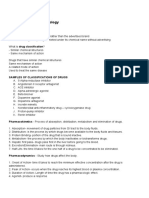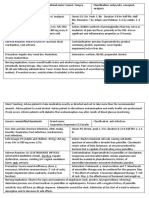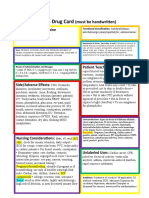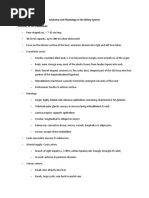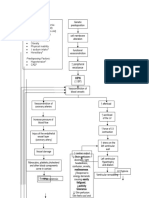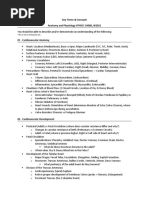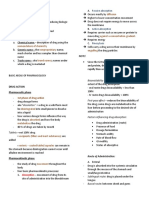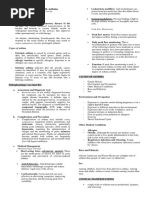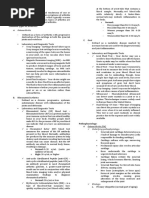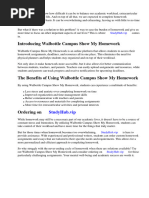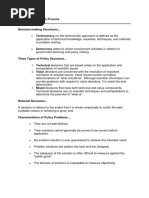0 ratings0% found this document useful (0 votes)
63 viewsPrinciples For All Medication
Principles For All Medication
Uploaded by
Belle Makinano1. The document provides principles and guidelines for safely administering medications to clients, including verifying orders, preparing medications carefully, identifying clients, and monitoring for side effects.
2. Special procedures are outlined for different administration routes like oral, ophthalmic, otic, nasal, topical, and parenteral.
3. Key steps include preparing a quiet environment, performing hand hygiene, checking the medication against the label multiple times, and staying with the client until the medication is taken.
Copyright:
© All Rights Reserved
Available Formats
Download as DOCX, PDF, TXT or read online from Scribd
Principles For All Medication
Principles For All Medication
Uploaded by
Belle Makinano0 ratings0% found this document useful (0 votes)
63 views6 pages1. The document provides principles and guidelines for safely administering medications to clients, including verifying orders, preparing medications carefully, identifying clients, and monitoring for side effects.
2. Special procedures are outlined for different administration routes like oral, ophthalmic, otic, nasal, topical, and parenteral.
3. Key steps include preparing a quiet environment, performing hand hygiene, checking the medication against the label multiple times, and staying with the client until the medication is taken.
Original Description:
pppp
Original Title
Pharmacology Notes
Copyright
© © All Rights Reserved
Available Formats
DOCX, PDF, TXT or read online from Scribd
Share this document
Did you find this document useful?
Is this content inappropriate?
1. The document provides principles and guidelines for safely administering medications to clients, including verifying orders, preparing medications carefully, identifying clients, and monitoring for side effects.
2. Special procedures are outlined for different administration routes like oral, ophthalmic, otic, nasal, topical, and parenteral.
3. Key steps include preparing a quiet environment, performing hand hygiene, checking the medication against the label multiple times, and staying with the client until the medication is taken.
Copyright:
© All Rights Reserved
Available Formats
Download as DOCX, PDF, TXT or read online from Scribd
Download as docx, pdf, or txt
0 ratings0% found this document useful (0 votes)
63 views6 pagesPrinciples For All Medication
Principles For All Medication
Uploaded by
Belle Makinano1. The document provides principles and guidelines for safely administering medications to clients, including verifying orders, preparing medications carefully, identifying clients, and monitoring for side effects.
2. Special procedures are outlined for different administration routes like oral, ophthalmic, otic, nasal, topical, and parenteral.
3. Key steps include preparing a quiet environment, performing hand hygiene, checking the medication against the label multiple times, and staying with the client until the medication is taken.
Copyright:
© All Rights Reserved
Available Formats
Download as DOCX, PDF, TXT or read online from Scribd
Download as docx, pdf, or txt
You are on page 1of 6
PRINCIPLES FOR ALL MEDICATION 3rd: Check bed tag (this is least reliable method
14. Provide privacy if needed.
1. Verify all new or questionable orders. 15. Inform client of medication, any procedure, technique, purposes,
2. Prepare medications in a quiet environment. and client teaching as applicable.
3. Perform hand hygiene. Observe standard precautions as 16. Stay with the client until medication is taken. Do not leave
appropriate. medication at bedside.
4. Collect all necessary equipment including straws, juice, water or 17. Give the medication within 30mins of prescribed time.
stethoscope. 18. Assist client if needed and leave in a comfortable position.
5. Review the medication administration record carefully to ensure 19. Chart administration immediately in ink, marking your initials in
safety, note: the appropriate space.
Medication dosage 20. Document the rationale if the drug is not administered.
Route 21. Report any errors immediately and complete appropriate
Expiration date institutional document.
Frequency 22. Liquid medications (all routes of administration) MUST NOT be
6. Research drug incompatibilities, action, purpose, mixed together unless of compatibility is verified.
contraindications, side effects and appropriate routes. 23. Prepare drugs for administration in a quiet, well-lit area.
7. Calculate the dosage accurately. Confirm normal range of dose, 24. Never remove a drug from an unlabeled container or from a
particularly in pediatrics. container whose label is illegible.
8. Check expiration date. Look for changes that indicate for 25. Do not let hands touch capsules or tablets.
decomposition (color, odor, clarity) 26. Always observe aseptic technique when handling syringes and
9. Compare label three times with the medication to decrease risk needles.
for error: 27. Be alert for drugs with similar names.
1st: When removing package from the drawer. 28. Replace the caps of drug containers immediately after the drug is
2nd: Before preparing the medication removed.
3rd: After preparing medication 29. Return drugs requiring special storage to the storage area
10. Check need for pm medications. immediately after they are prepared for administration.
11. Be sure medications are identified for each client. 30. Evaluate patient’s response to the drug. Document both negative
12. Check for any allergies and perform all special assessment before and positive reactions.
administration 31. Observe the ten rights in drug administration.
13. Confirm identity by checking at least two of the three possible 32. To ensure safety, do not give a medication that someone else
mechanism for identification. prepared.
1st: Ask client his name 33. When using a unit dose system:
2nd: Check client’s identity-band
Do not remove the wrappings of the unit dose until the Iron – have client use straw to prevent staining of the
drug reaches the bedside of the patient who is to receive teeth.
it. 8. Use gloves if you place your finger in client’s mouth.
After administering the drug, the nurse charts
immediately on the unit dose drug form. Special Concerns
1. Use a calibrated dropper, or syringe to give medications to infant.
Keep infant at 45 degree angle.
1. Special assessment: diet status, level of knowledge, oral cavity See if medication is available in liquid form if child is
and ability to swallow. unable to swallow.
2. Use mortar and pestle to crush tablets, if appropriate. Be sure not to use child’s favorite food as this may result
Enteric coated tables should not be crushed. Only scored in distrust.
tablets can be broken. 2. For rectal suppository
3. Capsule content may be mixed with food, except time-release Insert suppository, tapered end first (approximately 2
capsules. inches)
4. Give medication with 60-100 ml of water or juice, unless Hold buttocks together
contraindicated (e.g. cough syrup) Encourage to retain suppository for 15-20 minutes to
5. Preparation of liquid medications: allow suppository to melt.
Shake to mix.
Pour away from bottle label Administration of Nasal Medication
Read liquid amount at meniscus (eye level) 1. Have client blow nose to clear mucus
Do not administer alcohol-based products (e.g elixirs) to 2. Position client so that head can be tilted back to aid a
alcohol-dependent persons gravitational flow
6. Sit client upright to ensure swallowing 3. Push up on tip of nostril
7. Have client swallow medication except: 4. Place dropper or atomizer angled slightly upward just inside
Sublingual route – DO NOT swallow fluid for 30mins nostril (careful not to touch nose with applicator)
following administration 5. Remind client to keep head tilted for 5mins.
SL; from the Latin for “under the 6. Inform that drops may produce an unpleasant taste.
tongue” by which substances 7. Instruct just to wipe nose not blow
diffuse into the blood through 8. If client aspirates and begins to cough, let the client sit upright.
tissues under the tongue. 9. If client is an infant, lay infant on his/her back.
Buccal route – medication between cheek and gum. No
fluid after administration.
Administration of Ophthalmic Solution 2. Cleanse area of old medication using gauze pads with soap and
warm water.
1. Check solution for color and clarity 3. Use gloves and gauze, tongue depressors or sterile applicator if
2. Warm solution in hands before administration integument is broken.
3. Have client lie on back or sit with head turn to affected side. 4. Spread medication over the site evenly and thinly
4. Cleanse eyelid and eyelashes with sterile gauze pad soaked with 5. If necessary, cover area loosely with a dressing
physiologic saline.
5. Have client look up Special Concerns
6. Keep eye open by gently pulling down the skin below the eye to
expose the lower conjunctival sac. 1. When applying nitroglycerin ointment, take client’s blood
7. Place drops into lower conjunctiva near outer canthus (less pressure 5 minutes before and after application
sensitive than cornea) 2. Wash hands after applications to prevent self-absorption
8. If using ointment, squeeze into lower conjunctiva (from inner to 3. When using transdermal patches, use glove to avoid inadvertent
outer canthus) drug absorption. Place patch in area with little hair.
Let client blink 2-3 times.
Parenteral Route
Ophthalmic medications are for individual clients only.
Angles for inserting injections:
Administration of Otic Medications
a. Intramuscular – 90 degrees
1. Warm medication in hands before administering. b. Subcutaneous – 45 degrees
2. Have client slightly tilt head at unaffected side to aid gravitational c. Intravenous – 25 degrees
flow
d. Intradermal – 10-15 degrees
3. Clean outer ear using a wet gauze pad
4. Straighten ear canal by pulling pinna Subcutaneous Route
Up and back for adults
Down and back for infants and children under 3 years old 1. Use size 25-27 G, ½ - 1 inch needle, maximum volume is 1.5
5. Maintain position of ear for 5-10 minutes until medication has ml
totally reached inner ear. 2. Pinch skin to form SC fold
3. Insert needle at 45 degree angle in thigh or arm (to avoid
Administration of Topical Agents entering muscle)
4. 90 degree angle in the abdomen
1. Provide privacy and expose only appropriate area to provide
comfort
Possible sites: d. Deltoid – only for small volumes (0.5 – 1ml); use for
immunizations in toddles, older children and adults but NOT for
a. Lateral aspects of upper arm infants; check site carefully, axillary nerve lies beneath deltoid
b. Anterior thigh muscle
c. Abdomen: 2 inches away from umbilicus e. Dorsogluteal – not preferred due to proximity to sciatic nerve
d. Back, in scapular area
Z-track Technique
Intradermal Route
1. For irritating solutions; needle size 20-22 G
1. Use size 26-27 G 1-inch needle on a 1 ml or tuberculin syringe 2. Pull away skin away from the site laterally with non-dominant
(volume will be approximately 0.1 ml) hand to ensure medication enters muscle
2. Stretch skin taut 3. Wait 10 seconds after injecting medication before withdrawing
3. Insert needle 10-15 degrees angle needle
4. Release skin; do not massage (seals needle track)
Possible sites:
5. Encourage physical activity
a. Ventral mid-forearm
Possible sites:
b. Scapula
c. Upper chest a. Gluteus medius: Best but may use other sites except deltoid.
When wheal appears, remove the needle, and do not
massage it
Intramuscular Route
1. Needle size 18-23 G, 1-2 inches needle; maximum volume is 5ml.
Sites for IM injections:
a. Ventrogluteal – anterior-superior iliac spine, iliac crest, greater
trochanter of the femur
b. Vastus Lateralis – preferred site for immunization of infants.
Muscle is well developed and not located near major nerves or
blood vessels.
c. Rectus Femoris (medial thigh) – a handbreath above knee and
below greater trochanter; good site for infants and self-injection
PHASES OF DRUG ACTIVITY To decrease the effects of the stomach’s acid barrier, and the
direct effects of certain foods, ORAL drugs ideally should be given
Dose Disintergration of dose from dissolution of drug 1 hour before or 2 hours after a meal.
(Pharmaceutical Phase)
Drug Absorption of Various Dosage Forms
Oral Preparations: (fastest to slowest)
Absorption, Distribution, Metabolism, Elimination (Pharmacokinetic Phase)
a. Liquid, elixirs, syrups f. coated tablets
b. Suspension solutions g. enteric - coated
c. Powders
Drug receptor interaction (Pharmacodynamic Phase)
d. Capsules
e. Tablets
Effect Bioavailability
Pharmaceutics A term used to express the extent of drug absorption
Refers to the percentage of the administered drug that reaches
The study of how various drugs form influence pharmacokinetic the systemic circulation and eventually its site of action
and pharmacodynamic activities Significance: differences in bioavailability leads to variable drug
Pharmaceutic phase or dissolution refers to the reduction of drugs responses
in slid form into smaller particles and their dissolution into a liquid Dangers of Drugs with a Narrow Therapeutic Range: a relatively
to facilitate absorption. small change in the drug level in those type of drugs can produce
After ingestion, solid drug (tablet or capsule) must first a significant change in the response.
disintegrate into smaller particles A small decline in drug level = Therapeutic failure; A small
Smaller particles are dissolved into liquid, ready for absorption in increase in drug level = Toxicity
the gastrointestinal tract
Bioequivalent
Always remember that…
If two medications have the same bioavailability and the same
Drugs in liquid form are more rapidly available for GIT absorption concentration of active ingredient.
than solids. Examples: Paracetamol & Biogesic
Food in the GIT may interfere pharmaceutics Furosemide & Lasix
Milk, alcohol, and protein speed up the breakdown of many drugs Captopril & Capoten
Others may chemically bind drugs or block their absorption.
Factors Influencing Drug Effects
a. Weight:
Recommended dosage of a drug is based on drug evaluation
studies:
Targeted at a 150 pound person
Doses are adjusted by patient’s weight
Toxic effects may occur at the recommended dosage if
the person is very small
b. Age
Children have immature systems for handling drugs
Older adults undergo many physical changes that are part
of aging process
Bodies may respond differently in all aspects of
pharmacokinetics
Pediatric Dosages
Fried’s Rule:
Infant’s dose (<1 year) = infant’s age (in months)
150 months x average adult dose
Young’s Rule:
Child’s dose (1-12 years) = child’s age (in years)
Child’s age (in years) + 12 x average adult dose
You might also like
- DC Machines Solved Problems CharulathaDocument59 pagesDC Machines Solved Problems CharulathaShang Divina Ebrada88% (80)
- Clinical Parasitology OutlineDocument5 pagesClinical Parasitology OutlineLynneth Mae Beranda CorpusNo ratings yet
- Insulin ChartDocument1 pageInsulin ChartGabriel TaylorNo ratings yet
- Intermediate Math For Nurses NAME - WorkbookDocument7 pagesIntermediate Math For Nurses NAME - WorkbookRaniela MaeNo ratings yet
- Nursing Pharmacology Inflammation Study GuideDocument11 pagesNursing Pharmacology Inflammation Study GuideChelsea Smith100% (1)
- Argus 5 1 Test CasesDocument11 pagesArgus 5 1 Test CasespponnapatiNo ratings yet
- Pharmacology Test 3 ReviewDocument6 pagesPharmacology Test 3 ReviewNatalia BortellNo ratings yet
- Common Drugs in The Labor Room and Delivery RoomDocument4 pagesCommon Drugs in The Labor Room and Delivery RoomBelle MakinanoNo ratings yet
- Basic Pharmacology HandoutsDocument16 pagesBasic Pharmacology HandoutsRS BuenavistaNo ratings yet
- Pharma NotesDocument8 pagesPharma NotesKylahNo ratings yet
- Pharm ReviewDocument14 pagesPharm ReviewangieswensonNo ratings yet
- Concept Map Diagnosis and InterventionsDocument3 pagesConcept Map Diagnosis and Interventionsmenickel3No ratings yet
- Chapter 45-Antiarrhythmic AgentsDocument13 pagesChapter 45-Antiarrhythmic AgentsMelanie RodriguezNo ratings yet
- PharmacologyDocument7 pagesPharmacologyraquel maniegoNo ratings yet
- Vital Sign Na (1) by ZWBDocument52 pagesVital Sign Na (1) by ZWBAshraf Ali100% (1)
- Foundations of Pharmacology NotesDocument5 pagesFoundations of Pharmacology NotesSheril MarekNo ratings yet
- Anatomy and Physiology OutlineDocument13 pagesAnatomy and Physiology OutlineChester RiogelonNo ratings yet
- Anatomy and Physiology ReviewerDocument10 pagesAnatomy and Physiology ReviewerMae Christelle FigueroaNo ratings yet
- Pharmacology by DoctorDocument3 pagesPharmacology by DoctorLae DujonNo ratings yet
- Pharm Chapter 2 and 3 Study GuideDocument10 pagesPharm Chapter 2 and 3 Study GuideamkNo ratings yet
- Mechanisms of Drug Interactions: A. AbsorptionDocument4 pagesMechanisms of Drug Interactions: A. AbsorptionAnne Geleen BraganzaNo ratings yet
- All Types of InsulinDocument18 pagesAll Types of Insulinali mohammedNo ratings yet
- Med Admin Practice QuestionsDocument5 pagesMed Admin Practice QuestionsArmelle DelvaNo ratings yet
- Pharmacology Test 1Document39 pagesPharmacology Test 1Niki BolinNo ratings yet
- Pharm Exam Ii NotesDocument24 pagesPharm Exam Ii Noteskatiana louisNo ratings yet
- Sources Hormone FunctionDocument2 pagesSources Hormone FunctionKatherine Joy MaderajeNo ratings yet
- Diagnostic Tests A. Endoscopy: Nursing ConsiderationsDocument3 pagesDiagnostic Tests A. Endoscopy: Nursing ConsiderationsMae GabrielNo ratings yet
- Hytension For 16 Years Men (64 Years Old) Cigarette Smoking (32 Pack Years) Alcoholic Drinker For 32 Years Fond of Eating Fatty Foods Physical Inability Sodium Intake HereditaryDocument3 pagesHytension For 16 Years Men (64 Years Old) Cigarette Smoking (32 Pack Years) Alcoholic Drinker For 32 Years Fond of Eating Fatty Foods Physical Inability Sodium Intake HereditaryJohn Paulo CatacutanNo ratings yet
- Pharmacology LectureDocument18 pagesPharmacology LectureChloe MorningstarNo ratings yet
- Introduction To PharmacologyDocument119 pagesIntroduction To PharmacologyYzel Vasquez AdavanNo ratings yet
- Chapter 48 Urine EliminationDocument10 pagesChapter 48 Urine EliminationKathleen FrugalidadNo ratings yet
- Anatomy and PhysiologyDocument2 pagesAnatomy and Physiologyaldrin19No ratings yet
- Math Practice 4 - 13Document15 pagesMath Practice 4 - 13Haley PNo ratings yet
- DrugmedsDocument52 pagesDrugmedsshirleyNo ratings yet
- Antidotes To Commn MedicationDocument1 pageAntidotes To Commn Medicationjosephabram051590No ratings yet
- Anatomy and PhysiologyDocument15 pagesAnatomy and PhysiologyMary Joy LambinoNo ratings yet
- Anatomy and PhysiologyDocument4 pagesAnatomy and PhysiologyAaron Jacob Omaña100% (1)
- 106 Prefi Critical Care Nclex ReviewDocument10 pages106 Prefi Critical Care Nclex ReviewraigeneNo ratings yet
- Lesson 1 - Module 1 - Circulatory SystemDocument27 pagesLesson 1 - Module 1 - Circulatory SystemPapiNo ratings yet
- Textbook Preface PDFDocument13 pagesTextbook Preface PDFRobert StevenNo ratings yet
- Pharmacology Phar681 Drug List FALL 2013: Pharmacokinetics Cholinergic AntagonistsDocument10 pagesPharmacology Phar681 Drug List FALL 2013: Pharmacokinetics Cholinergic AntagonistsWilliam JonesNo ratings yet
- Anticancer Drugs: Pharmacology 2Document74 pagesAnticancer Drugs: Pharmacology 2Hannah Laput100% (1)
- PharmacologyDocument9 pagesPharmacologyRPh Krishna Chandra JagritNo ratings yet
- Adrenergic DrugsDocument22 pagesAdrenergic DrugsDan Mark Lavega OmadleNo ratings yet
- Review Notes For Diabetes MellitusDocument8 pagesReview Notes For Diabetes MellitusEditha LucasNo ratings yet
- Week 13 Drug CardsDocument5 pagesWeek 13 Drug CardsPRECIOUS wardNo ratings yet
- Anatomy and Physiology of The Biliary SystemDocument5 pagesAnatomy and Physiology of The Biliary SystemstephenlopezNo ratings yet
- Pathophysiology CHFDocument3 pagesPathophysiology CHFKit LaraNo ratings yet
- 1 Juliane Flores Bible FinalDocument170 pages1 Juliane Flores Bible FinalJuliane FloresNo ratings yet
- Pharma Lec PrelimDocument40 pagesPharma Lec PrelimjoanaalpayNo ratings yet
- A&P Key Terms & Concepts W21 AppendDocument20 pagesA&P Key Terms & Concepts W21 Appendpu bNo ratings yet
- Barbiturates: of Action of GABA. Independent of GABADocument10 pagesBarbiturates: of Action of GABA. Independent of GABAAvi WerdesheimNo ratings yet
- Pharm ReviewDocument5 pagesPharm ReviewChelsea ChanceNo ratings yet
- Vitamin CDocument11 pagesVitamin CFrancia PalinesNo ratings yet
- Anatomy and PhysiologyDocument2 pagesAnatomy and PhysiologyKamille Jeane Stice CavalidaNo ratings yet
- Chapter 10 Endocrine SystemDocument8 pagesChapter 10 Endocrine SystemCriscia Lene OlatNo ratings yet
- Safety of High Alert MedicationDocument48 pagesSafety of High Alert Medicationrini setyawatiNo ratings yet
- Medication AdministrationDocument67 pagesMedication AdministrationGrajo, Roxanne T.No ratings yet
- N461 - Final Exam Study Guide - RN-BS - Spring 2017Document7 pagesN461 - Final Exam Study Guide - RN-BS - Spring 2017Jeffrey ViernesNo ratings yet
- Pharmacology Notes #1 DRUG ACTIONDocument4 pagesPharmacology Notes #1 DRUG ACTIONAyumi StarNo ratings yet
- Routes of Administration of Therapeutic AgentsDocument9 pagesRoutes of Administration of Therapeutic AgentsKeemuel LagriaNo ratings yet
- Care of Women and Families During PostpartumDocument3 pagesCare of Women and Families During PostpartumBelle MakinanoNo ratings yet
- Drug Study AmbroxolDocument2 pagesDrug Study AmbroxolBelle MakinanoNo ratings yet
- Care of Patients With Asthma: Peak Flow MonitoringDocument2 pagesCare of Patients With Asthma: Peak Flow MonitoringBelle MakinanoNo ratings yet
- Cardiovascular Drugs: D. Hormone DeliveryDocument8 pagesCardiovascular Drugs: D. Hormone DeliveryBelle MakinanoNo ratings yet
- Homeostatic Imbalances in The SkinDocument1 pageHomeostatic Imbalances in The SkinBelle MakinanoNo ratings yet
- A. Osteoarthritis: UnderstandingDocument4 pagesA. Osteoarthritis: UnderstandingBelle MakinanoNo ratings yet
- Concept of Family & Family Nursing ProcessDocument3 pagesConcept of Family & Family Nursing ProcessBelle MakinanoNo ratings yet
- Continuation Sa PregnancyDocument3 pagesContinuation Sa PregnancyBelle MakinanoNo ratings yet
- Rina LinguisticDocument2 pagesRina LinguisticUlfaNo ratings yet
- Summer Training Project Report: ON "Performance Appraisal of Britannia Industries Limited"Document96 pagesSummer Training Project Report: ON "Performance Appraisal of Britannia Industries Limited"Panu BishtNo ratings yet
- Thesis Administrative ManagementDocument8 pagesThesis Administrative Managementybkpdsgig100% (1)
- Glo Fish 10 Facts V5Document1 pageGlo Fish 10 Facts V5bluegreenalgaNo ratings yet
- TLE6 CapSLET Agri Q1 W5Document17 pagesTLE6 CapSLET Agri Q1 W5ALRAEIS ABDULHAMIDNo ratings yet
- SPF HIS All-In-One Handpolish For High Gloss and Slip CAR-4056 USDocument2 pagesSPF HIS All-In-One Handpolish For High Gloss and Slip CAR-4056 USreza100% (2)
- Prediction and Analysis of Gear Rattle: Development TransmissionsDocument5 pagesPrediction and Analysis of Gear Rattle: Development TransmissionssmsnvhNo ratings yet
- SQL Lite Create, DeleteDocument26 pagesSQL Lite Create, Deleteekosup442No ratings yet
- Rexrot Menjač R902096008 - en - 7648 - 8036 - 20110427165737Document17 pagesRexrot Menjač R902096008 - en - 7648 - 8036 - 20110427165737Munja KlanaNo ratings yet
- COA_Module4Document19 pagesCOA_Module4nithyaniharikabv2005No ratings yet
- InvoiceDocument2 pagesInvoiceReza Andhitya PutraNo ratings yet
- Walbottle Campus Show My HomeworkDocument4 pagesWalbottle Campus Show My Homeworkersanb3k100% (1)
- Battery Size Calculator 22 8 12Document3 pagesBattery Size Calculator 22 8 12MANIKANDANo ratings yet
- Design and Fabrication of Shaft Driven Bicycle PDFDocument46 pagesDesign and Fabrication of Shaft Driven Bicycle PDFmustufa akolawalaNo ratings yet
- Britain in The 20 CenturyDocument28 pagesBritain in The 20 CenturyKate NaumovaNo ratings yet
- Comsats: University IslamabadDocument16 pagesComsats: University IslamabadHenry HowardNo ratings yet
- What Are The Different Types of PollutionDocument9 pagesWhat Are The Different Types of PollutionPatricia DurandNo ratings yet
- Section 3 Solutions PDFDocument5 pagesSection 3 Solutions PDFSam javaNo ratings yet
- TakadDocument4 pagesTakadshahnewaz.eeeNo ratings yet
- Introduction To Genric DrugDocument60 pagesIntroduction To Genric Drugganesh_orcrdNo ratings yet
- Chapter 3.2 - Customs of The TagalogsDocument10 pagesChapter 3.2 - Customs of The TagalogsAbedel Rahman Omar AlloushNo ratings yet
- Tolman 1955Document12 pagesTolman 1955Maggý MöllerNo ratings yet
- Kitaab At-Tawheed Complete - RESIZEDDocument232 pagesKitaab At-Tawheed Complete - RESIZEDToyib D'SenatorNo ratings yet
- Materi Untuk Tugas Topik 2Document11 pagesMateri Untuk Tugas Topik 2Violen AmeliaNo ratings yet
- The Policy Analysis ProcessDocument3 pagesThe Policy Analysis Processeric3215100% (1)
- Unrestricted Submarine WarfareDocument10 pagesUnrestricted Submarine Warfareapi-37276110% (1)
- By MuetDocument4 pagesBy MuetNur AsyuraNo ratings yet
- Assignment 1Document2 pagesAssignment 1nancy9hongNo ratings yet
- Sleep Information Sheet - 06 - Imagery RescriptingDocument2 pagesSleep Information Sheet - 06 - Imagery RescriptingMiracle WhitesNo ratings yet






